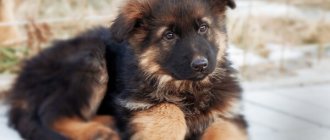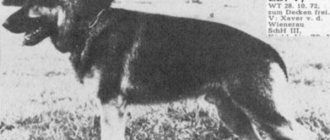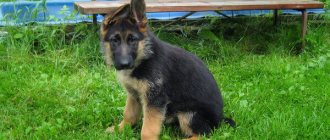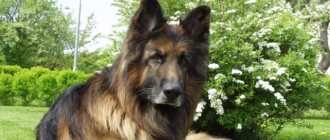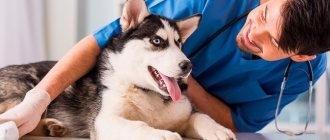The German Shepherd breed has long won the hearts of mankind.
They have all the qualities that a true friend needs.
Moreover, not a single patrolman or policeman can do without these dogs.
They are not only loyal friends, but also brave defenders who will do everything to save their owner.
So how do you choose a puppy?
Let's find out in detail from the article.
At what age are weaned from the mother?
Weaning too early can have a negative impact on the puppies' psyche . This moment must be timely, it must be chosen correctly.
Weaning should occur before the first vaccination . It is done at 2 months.
At 3-4 weeks, complementary foods are already introduced for puppies, which means that weaning from the mother should occur gradually by 5-6 weeks.
In order not to suddenly deprive the puppies of their mother's milk, it is allowed to let the puppies suckle at night. Over time, this too will have to be eliminated.
Common features
The message refers to the pet's tail. The tail of a purebred dog looks straight, saber-shaped and droops downwards. But judging by a single sign is wrong. The tail can change as it grows, you need to look at the totality of signs.
Purebred puppies often look awkward at first. By about two months, they begin to grow very quickly and gain weight, literally before our eyes. The body stretches out and gains the proportions necessary for a shepherd dog. Mutts don't grow that fast.
What types of German Shepherds are there?
German There are several classifications to divide German Shepherds: by coat length, by color and by breeding line.
Types of German Shepherds by coat length:
- Short-haired. The coat of such shepherds is thick, short and close to the body. They have a good undercoat. The fur on the neck, tail and hips is longer than on the rest of the body;
- Long-haired. These dogs have soft, slightly wavy fur with an undercoat. The dog has a parting on its back. The especially thick coat on the neck and behind the ears, behind the ears and on the back of the paws forms feathering.
Crossing long-haired and short-haired shepherd dogs is prohibited . These are two different breeds, breeding records are kept separately.
Types of German Shepherds by color:
- Black. The rarest color for German Shepherds, only 5% have it. Black dogs of this breed are the real elite;
- Black and tan. The body is black, and the stomach and paws on the inside are light.
- Zonal. Each hair is colored in ring zones: light, then black, yellow, black.
- Black-and-white. The fur on the back is black, the belly, neck and limbs have tan markings of various colors: chocolate, reddish, yellow, fawn, gray. The muzzle is black or gray;
- White. A German Shepherd can be white if both parents have the recessive gene responsible for this color. In Canada, they even managed to develop a separate breed of such dogs.
The red color of the German Shepherd does not meet the standard, but this does not prevent it from becoming your pet and friend. This also applies to the gray color.
Types of dogs by breeding line:
- West Germany . It is a high breeding line. These dogs are best suited to the show standard. The dog's appearance was detrimental to its overall qualities. Such dogs are not suitable for official duties;
- Western operating lines - Czech/Slovak, East German , Dutch, Belgian . These dogs, on the contrary, have everything to become excellent service pets. They differ from their West German relatives;
- American line . The Americans focused on the appearance and ease of movement of the dog, because of this, their build is slightly different from their other brothers. American line dogs are balanced, calm and easy to train;
- English line . Their ancestors are sheepdogs brought to England in the mid-20th century. Over time, they were practically driven out of the island by their continental relatives.
Let's compare both breeds
To get as close as possible to the answer: which of the two pets is stronger, we will analyze each breed separately and compare them with each other.
Exterior
First, let's look at the external characteristics of both breeds.
Doberman:
- The Doberman has a large and muscular build. The height at the withers is slightly greater than that of shepherd dogs - in females it reaches 68 centimeters, in males up to 72 centimeters.
- The weight is also slightly different. Female Dobermans weigh up to 35 kilograms, and male Dobermans weigh up to 45 kilograms.
- Their coat is quite short and does not contain undercoat. It is polished, has a rigid structure and does not curl.
- The coat color is mainly charcoal, with small brown and red spots.
- The muzzle of representatives of this breed is elongated, the eyes are dark and round in shape, the ears are erect, and they are often cropped.
- The tail is also short due to docking. The back is straight, the sternum is wide.
- The neck is elongated and thick.
- The limbs are straight, parallel to each other.
- The claws are long and dark in color.
Shepherd:
- The Shepherd also has a proportional build. The height of males reaches 65 centimeters at the withers, females - up to 60 centimeters. However, Dobermans are taller. Shepherd girls weigh up to 32 kilograms, boys - up to 40 kilograms.
- The coat of German Shepherds can be short or long and has a pronounced undercoat. She is straight and tough.
- The color of the fur coat can be of different shades: ranging from coal-black, saddle-back with red and gray spots to zone-red or zone-gray.
- The mouth is slightly shorter than that of Dobermans, the nose is black. The muzzle itself is dark in color.
- The eyes are oval and have brown or black shades.
- The chest is wide and muscular.
- The back is flat and often black.
- The limbs are straight and parallel to each other.
The character of the Doberman is distinguished by playfulness and friendliness, and not anger, as everyone is accustomed to think. The Doberman is a very sensitive and loyal animal with a peculiar disposition. They are independent, sometimes too independent.
Such pets instantly react to the slightest manifestation of aggression and are able to rush into battle without sparing themselves. Representatives of the Doberman breed show aggression only if the owner or members of his family are in danger and someone is making an attempt on their life. However, they behave well with other pets and get along well with them. Dobermans are calm towards small children.
As for the German Shepherd, its character and behavior are slightly different. This animal cannot live without a person and his attention. The Shepherd has a calm disposition and a balanced psyche. If the dog notices that someone is trying to harm the owner, it will immediately begin to protect him.
In a family, she usually chooses one leader, listens to him unquestioningly and is faithful to the person until the end of her days. In addition, shepherd dogs are friendly towards small children and are able to play the role of a nanny for them. They treat cats calmly, but they may not get along with some dogs.
Attitude to training
Of course, any breed needs to be raised and trained. This is especially true for Dobermans. But when training these pets, you need to show ingenuity and a special approach. Sometimes Dobermans can be stubborn and play around without listening to their owner.
However, their learning abilities are very great. Of course, they need to be constantly improved. The Doberman, as mentioned above, is a very sensitive pet; it can sense the owner’s mood and mirror his behavior.
The German Shepherd behaves completely differently when trained. She carefully and easily follows commands and remembers them well. However, if you abandon training, the dog will forget everything completely, and training will need to start all over again.
Therefore, the shepherd’s brain requires constant mental work, and physical activity is required to maintain muscle tone. The Shepherd always unconditionally listens to the one he has chosen as an authoritative owner.
How to distinguish from a mongrel?
Anyone can distinguish a purebred shepherd at 5 or 6 months from a mongrel, but not every buyer can do this at 1 or 2 months.
The main rules that will allow you to avoid being deceived:
- When purchasing, ask where the puppy’s parents are and ask to show them. Also find out what documents the parents have. To be 100% sure, you can call the Club and find out if these dogs are registered there;
- Puppies must be branded. The data on the stamp and in the metric must match;
- The puppy's eyes have an almond-shaped cut; when they turn their head, the white white is visible. Because of this, the eyes of the “German” are often compared to human ones;
- The iris can be from dark yellow to dark brown. The eyes may be blue for up to two months. Mutts have protruding, white, yellowish or speckled eyes.
- By the beginning of the shift, the shepherd dog should have 28 teeth. It is unacceptable for them to grow together or have an incorrect bite;
- The head of a purebred puppy should be proportional to the body. The forehead should not hang over the muzzle. There should be no beard between the eyebrows. The nose is black without a point. Lips in the color of your nose;
- Neck of medium length;
- The back is short and strong, the chest does not fall below the elbows;
- The tail should be long, it never rolls into a ring, and is always straight;
- The paws are large and large;
- The usual color of the German Shepherd is saddleback, but others are allowed. There may be a white martin on the chest, but spots inside it are not allowed;
- A purebred puppy will not be afraid of a person, but will try to follow any of his instructions - this is on a subconscious level. Mongrels avoid people. Also subconsciously.
Main features: head
The head of a true German is moderately developed and proportional from an early age. The forehead is slightly convex and not wide. The transition from the forehead to the muzzle in the early stages of development is not too sharp, the muzzle is not as pointed as in adults. The nose is relatively large and black. In mongrels, unlike purebred shepherd dogs, the frontal sulcus is clearly developed. Five clearly visible moles are found near the corners of the animal's mouth - a distinctive feature of the breed.
The eyes of a natural German are often dark brown, without spots, and almond-shaped. In small puppies the color may be smoky blue. The eyes of mongrel dogs look bulging and round. Shepherds have a focused and inquisitive look.
A natural German has a scissor bite, the gaps between the teeth do not exceed 1-2 millimeters. There are no fused or double teeth in the mouth.
A small puppy's ears appear either floppy or erect. By the age of 2 months, the dog’s ears rise and become erect. Mongrel dogs' ears do not rise and remain lop-eared forever.
What is the best age to buy?
Experts recommend taking puppies that have already been vaccinated, branded and weaned from their mother.
This is 3-4 months old . Some also take older Germans.
But you need to remember, the sooner you start raising a puppy, the greater your chances of success.
From the breeder you will receive the first recommendations on how to keep and feed your pet..
Where is the best place to buy - private owners, breeders, nurseries?
Your choice of location depends on the goals you are pursuing when purchasing a dog.
If you are interested in the exhibition and competition career of an animal, then you need a show-class pet that meets all standards and has all the documents on the breeding pedigree . In this case, you will have to fork out money and buy a dog in a kennel or from a breeder.
Breed-class dogs are most suitable for breeding, not exhibitions. You can also purchase such a puppy from the breeder.
If you just need a dog to spend time together, protect the territory, or for the soul, then a pet class is also suitable.
This type of shepherd dog can be bought from any private individual.
Expert opinion
Kozhevin Semyon Kirillovich
Expert dog handler.
“The right thing to do is to choose a place first. Before doing this, don’t be lazy, read reviews about the nursery or breeder. If you plan to take a puppy “from your hands”, be extremely careful, you risk choosing a “pig in a poke”. Look at what real German Shepherd puppies look like, at least on the Internet, get acquainted with their distinctive features, and then compare them with the dogs you choose from. If you have enough information in your head, you will never be deceived. Be persistent, ask, be interested. Often, even by the breeder’s reaction to questions, you can understand whether he is conscientious or not.”
Verification of documents
Checking the animal's documents is an important step in the process of purchasing a puppy. Not only the amount, but also the future life and health of the dog depends on them. The presence of metrics and a good pedigree will protect the new pet from many diseases and problems associated with breeding dogs and keeping them.
You should approach the choice of a puppy responsibly, since at this moment you are acquiring a friend with whom you will have to live for many years. The temperament of shepherds mixed with mongrels may differ from the standard, and therefore it is not recommended to take such risks. Determining whether an animal is purebred should be entrusted to a dog handler or a familiar breeder, since they have more information about the dogs.
Main rules - what to look for when buying
- Find out how many puppies were in the litter. If more than 10, then most likely the bitch had problems during childbirth and feeding;
- Look at the conditions in which the mother and puppies are kept, what they eat and where they sleep;
- Pay attention to the puppy’s appearance, its fatness and physical perfection;
- The puppy should not smell unpleasant, the mucous membranes should be clean;
- The forehead should not be too wide and the muzzle should not be pointed. Dogs have a scissor bite;
- The puppy should not fall while running; on the contrary, coordination should be good and there should be no lameness;
- The puppy's build should be proportional;
- Babies have coats without receding patches, most often saddle-colored.
The puppy's limbs should not be twisted, the tail of the German Shepherd should not be bent or crooked..
Advice from professionals
In order not to make a mistake when purchasing, as well as to raise a healthy and loyal dog, you need to listen to the advice of breeders.
A few rules to choose from: The kennel where the puppy is purchased must be recognized as a canine center of international standard. This is indicated by the seal on the front side of the certificate. Germans are prone to various diseases. For this reason, you need to familiarize yourself with the documents of the parents, check the certificate with stamps on the state of mental and physical health. The breeder must also provide a document containing an exterior rating and the result of a test of courage and endurance. After checking the documents, if the male and female live in the same city, the breeder must introduce them to the parents
When choosing a puppy, it is important to examine the entire litter; if the seller shows only part of the offspring, this may indicate that other puppies have serious illnesses or defects in appearance. Babies aged 2-2.5 months must have a brand. If it is missing, then the puppy did not receive a positive assessment during the breeding examination.
The German Shepherd is not the most expensive breed, but it is very popular. Because the dog is smart, hardy and loyal. When purchasing a puppy, you need to understand that the presence of a new family member in the house is a big responsibility, since you will have to walk with him in the rain, snow and wind, and also spend a lot of money on maintenance.
What does a healthy puppy look like?
A healthy German Shepherd puppy looks like a little bear.
NOTE!
The paws should be wide and compact; when looking at the dog from the front, its front paws and chest should form the letter A.
The back of puppies is smooth, dense and without any deflections.
The baby should have a wide pectoral girdle, their chest is deep . There should be no fifth toes on the hind legs - this is a defect. Also, the paws should not have any bumps. The tail is long and straight.
There should be no stiff ends on the ears - this indicates an excess of calcium, such ears may not stand up in the future. Blue eye color is allowed in the first months, then it begins to darken. At the same time, there should be no discharge from the dog’s eyes and ears.
Healthy puppies have no damage to their skin . It is elastic and soft.
Definition
The German Shepherd is a dog bred at the end of the 19th century in Germany as a service dog based on the Central and South German varieties of guard breeds, a descendant of the northern wolf. According to the FCI classification, it belongs to Group 1 – herding and cattle breeding. A self-confident, well-managed, good-natured dog with strong nerves.
German Shepherd
A mongrel is a dog that has not belonged to any breed for several generations, often homeless. Due to strict natural selection, it has good health.
First of all, it should be said that you need to study the breed standard very well before buying a dog. It is very difficult for a non-professional to distinguish a German Shepherd from a mongrel. But at least some conclusions can be drawn.
Cur
Assessment of mental and other abilities
To determine the intellectual abilities of a German shepherd, a special test by zoologist William Campbell has long been used.
It helps determine:
- The puppy's desire to communicate;
- Its ability to follow its owner;
- Puppy obedience level;
- The desire for dominance;
- Self-esteem.
But such a test can be carried out by a breeder or specialist, but you can only assess the general capabilities of the puppy.
Look at the parents and determine if they have cowardice, aggression or hysteria - this can be passed on to the puppy. The baby should be a curious little explorer.
If timidity in a puppy is also explained by the fact that it can suffer aggression from other brothers, but cowardice is not allowed in this breed.
The puppy should not be afraid of you, noise, not at all, he will be interested in sniffing and getting to know a new person.
The puppy must be socialized and communicate well with its other brothers and mother.
This will make your parenting task easier.
In general, the baby German Shepherd is lively and inquisitive, he is interested in exploring the world, showing interest in new things.
Key facts
The characteristics of the German Shepherd breed are as follows: they are large, strong and incredibly smart dogs with innate guarding, fighting and hunting skills. “Germans” are immensely devoted to their owner, very smart, and given proper upbringing and training, they are efficient and well prepared to perform dangerous tasks. These dogs are friendly and kind to others.
You can keep them in an apartment, but the best option for a pet is fresh air, plenty of space for movement, games, and training. They are very active, inquisitive and smart.
Dogs of this breed will be both excellent guards, “co-workers”, and excellent furry friends, protectors in the family. The most important thing for them is a person’s authority. They are ready to obey unquestioningly, learn, and carry out any commands. The process of training them goes quickly and clearly, because the “Germans” are one of the smartest dogs in the world. An important task for the owner is to start training and training as early as possible.
Interesting
: German Shepherds are wonderful actors, playing leading roles in action-packed films or luxury food commercials.
They do not provoke empty collisions with other animals; first they carefully study the surrounding environment and sniff. Of course, this behavior is achieved through hard training, strict education and the necessary attention.
Germans have a hypersensitive sense of smell. That is why they are used by dog handlers, various military intelligence services, military structures, and the police. They are naturally strong, fast and very agile.
Shepherds are truly incredibly active. It will not be difficult for them to run for hours after a stick or actively play all kinds of games. They need constant communication. For people who love regularity, calmness, or even passivity, this can be a huge inconvenience.
The description of the German Shepherd breed is based primarily on its working qualities. Therefore, the dog certainly needs constant attention from the owner. The lifespan of a German Shepherd depends on properly distributed physical and mental activity - without them, the dog quickly fades away.
Compatibility test
The puppy should suit your temperament and character. Therefore, play with him, observe how he behaves around his brothers. Also, it would not be amiss to conduct several tests with him in order to understand what character traits the puppy already has.
IMPORTANT!
See if he runs up to you as soon as you leave him, if he follows your call, how much he is subject to submission and dominance - to do this, turn him over on his back and try to hold him in this position, stroke him and look at the reaction, take him hold him in your arms and observe his behavior - whether the puppy can remain at a distance from the ground in your hands.
Based on the puppy’s reaction, draw conclusions about what he will become and whether you need a pet with such a character.
Who to choose - a boy or a girl?
Boys always have better conformation and are more successful in exhibitions. This is also due to the fact that females are subject to estrus twice a year, which means pregnancy and childbirth.
The latter factors are also worth keeping in mind when choosing a dog.
Do not forget that the male will also need the bitch, but all the consequences fall on her.
If you plan to make a show career, choose a male; a female is more suitable for breeding.
Otherwise, only the owner can choose which gender of pet he prefers.
Dog booth
If a person wants a shepherd to live in a kennel, you can buy one at a pet store or make one yourself. The second option will be more comfortable for the animal, because in a kennel made to the dog’s individual size, it is not cramped and warm.
Before building a booth, it is important to choose a good place to install it. The kennel should be positioned so that the bitch or dog can freely see the entire area and those who came
In addition, it is necessary that the soil under the booth is dry. You cannot place a dog house on bare ground; you must install a foundation or underlay underneath it. The optimal distance from the house to the booth is 15 meters. It is unacceptable for the kennel to stand in a barn or near other animals. It is important to remember that the length of the booth must be such that the animal in it can lie down freely and stretch out its paws.
Only straw should be used as bedding, but in no case cloth rags or hay. After all, they absorb moisture and swell.
Keeping the booth clean
In addition to the above maintenance and care requirements, it is necessary to ensure cleanliness in the booth. A good tip is that when installing a booth with your own hands, you need to make an opening type roof. This way, the owner can always change the bedding, wash the inside of the booth, or disinfect it against fleas. After all, cleaning the kennel must be done regularly and thoroughly.

